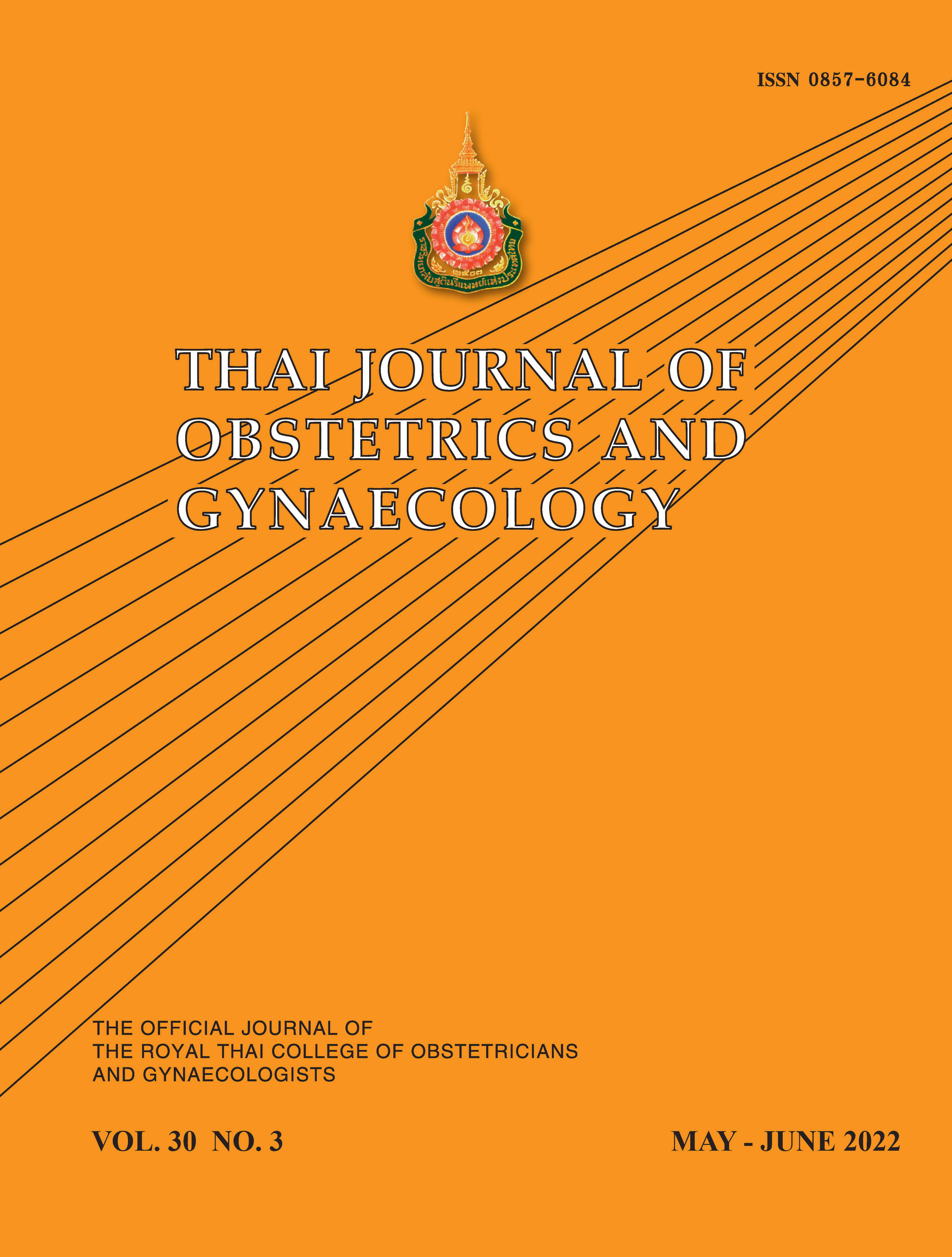Risk Factors Associated with Parametrial Involvement in Early-stage Cervical Cancer
Main Article Content
Abstract
Objectives: The study aimed to identify the risk factors affecting parametrial involvement in patients with early-stage cervical cancer.
Materials and Methods: The sample participated in the study was the patients with stage IA2 to IIA1 cervical cancer according to 2018 International Federation of Gynecology and Obstetrics (FIGO), who had been treated with radical hysterectomy and pelvic lymphadenectomy during April 2011 to April 2020. In term of methodology, the retrospective cross-sectional analysis was to determine the factors including tumor size, deep stromal invasion (DSI), lymphovascular space invasion (LVSI), pelvic node status, FIGO staging, age and histology (squamous cell carcinoma, adenocarcinoma and adenosquamous cell carcinoma), associated with parametrial involvement (PI).
Results: Overall, 19 of the 206 patients (9.22%) had PI. Patients with PI were more likely to have larger tumor size (> 4 cm: 15%, 2-4 cm: 10%, < 2 cm: 2%, p = 0.02), DSI (deep 1/3: 19%, middle 1/3: 2%, superficial 1/3: 0%, p = 0.01), LVSI (positive: 17%, negative: 3%, p < 0.01), metastasis to pelvic lymph nodes (positive: 50%, negative: 4%, p < 0.01), and higher FIGO stage (IB3: 16%, IB2: 10%, IB1: 3%, IA2: 0%, p = 0.02). Multivariate analysis showed that only deep stromal invasion (p = 0.02) and pelvic lymph node metastasis (p < 0.01) were independent risk factors for PI.
Conclusion: The deep stromal invasion and pelvic lymph node involvement were significantly associated with PI in multivariate analysis. Cervical cancer with superficial 1/3 stromal invasion and no pelvic lymph node metastasis seldom had PI.
Article Details

This work is licensed under a Creative Commons Attribution-NonCommercial-NoDerivatives 4.0 International License.
References
Bhatla N, Aoki D, Sharma DN, Sankaranarayanan R. Cancer of the cervix uteri. Int J Gynecol Obstet 2018;143:22-36.
Sangariyavanich E, Buasom R. Hospital-based cancer registry. Bangkok: New Thammada Press 2018:1-4.
Jiamset I, Hanprasertpong J. Risk factors for parametrial involvement in early-stage cervical cancer and identification of patients suitable for less radical surgery. Oncol Res Treat 2016;39:432-8.
Hacker NF, Vermorken JB. Cervical cancer. In: Berek JS, Hacker NF, editors. Berek & Hacker’s gynecologic oncology. 6th ed. Philadelphia: Wolters Kluwer 2015:326-89.
Wright JD, Grigsby PW, Brooks R, Powell MA, Gibb RK, Gao F, et al. Utility of parametrectomy for early-stage cervical cancer treated with radical hysterectomy. Cancer 2007;110:1281-6.
Frumovitz M, Sun CC, Schmeler KM, Deavers MT, Dos Reis R, Levenback CF, et al. Parametrial involvement in radical hysterectomy specimens for women with early-stage cervical cancer. Obstet Gynecol 2009;114:93-9.
Vanichtantikul A, Tantbirojn P, Manchana T. Parametrial involvement in women with low-risk, early-stage cervical cancer. Eur J Cancer Care 2017;26:1-5.
Cohen J. A power primer. Psychol bull 1992;112:155-9.
Kodama J, Kusumoto T, Nakamura K, Seki N, Hongo A, Hiramatsu Y. Factors associated with parametrial involvement in stage IB1 cervical cancer and identification of patients suitable for less radical surgery. Gynecol Oncol 2011;122:491-4.
Baiocchi G, de Brot L, Faloppa CC, Mantoan H, Duque MR, Badiglian-Filho L, et al. Is parametrectomy always necessary in early-stage cervical cancer? Gynecol Oncol 2017;146:16-9.
Dabi Y, Willecocq C, Ballester M, Carcopino X, Bendifallah S, Ouldamer L, et al. Identification of a low risk population for parametrial invasion in patients with early-stage cervical cancer. J Transl Med 2018;16:163-72.
Xie X, Song K, Cui B, Jiang J, Zhang Y, Wang B, et al. Significance of the factors associated with parametrial involvement in stage IB to IIA cervical cancer. Int J Gynecol Cancer 2016;26:939-43.
Lee SH, Cho KJ, Ko MH, Cho HY, Lee KB, Lim S. Factors associated with parametrial involvement in patients with stage IB1 cervical cancer: Who is suitable for less radical surgery? Obstet Gynecol Sci 2018;61:88-94.
Sedlis A, Bundy BN, Rotman MZ, Lentz SS, Muderspach LI, Zaino RJ. A randomized trial of pelvic radiation therapy versus no further therapy in selected patients with stage IB carcinoma of the cervix after radical hysterectomy and pelvic lymphadenectomy: a gynecologic oncology group study. Gynecol Oncol 1999;73:177-83.
Epstein E, Testa A, Gaurilcikas A, Di Legge A, Ameye L, Atstupenaite V, et al. Early-stage cervical cancer: Tumor delineation by magnetic resonance imaging and ultrasound - A European multicenter trial. Gynecol Oncol 2013;128:449-53.
Reade CJ, Eiriksson LR, Covens A. Surgery for early stage cervical cancer: how radical should it be? Gynecol Oncol 2013;131:222-30.


